We acknowledge that the final authority regarding these messages
rests
with the Holy See of Rome.
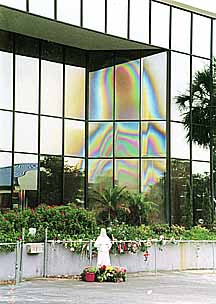
| Mary has requested that the daily message be given each day to the
world. It is read nightly at the prayer service from her Image Building in Clearwater,
Florida, U.S.A. This is according to her request. All attempts will be made to publish
this daily message to the world at 11p.m. Eastern time, U.S.A. We acknowledge that the final authority regarding these messages
rests |
 |
September 14, 2003
September 15th Holy Spirit Novena
Scripture selection is Day 8 Period I.The Novena Rosary Mysteries for September 15th are the Glorious.
An Afternoon with Mary
September 7, 2003
Please pray through the
intercession
of Father Carter and Our Lady of Clearwater
for healing for Margaret Mary.
We desperately need funds.

Call to apostles, servants, and handmaids
will be in China on the 13th of October.
Adoration will begin on Saturday
and end on the 14th.
More details will be available soon.
|
LISTEN TO NEW GREAT RECEPTION — www.sofc.org |
|
appears NOW on the web camera |
We desperately need funds.
Please call 1-888-211-3041
or 1-513-932-4451.
We accept credit card donations.
Schedule for September
15,
2003
Our Lady of Sorrows
4:00 a.m. - Mass4:37 a.m. - Mary's Message
4:43 a.m. - Songs & Messages October 24, 1995
5:46 a.m. - Morning Offering
5:50 a.m. - Songs
6:20 a.m. - 6:20 prayers led by Father Carter
Holy Spirit Novena
Shepherds of Christ Prayer Manual
Rosary7:24 a.m. - May 5, 2001 Rosary
8:36 a.m. - December 12, 2002 feast of Our Lady of Guadalupe
9:23 a.m. - Mary's Message
9:30 a.m. - Children praying the Shepherds of Christ prayers
9:48 a.m. - Live Rosary October 13, 1996
11:10 a.m. - Special Messages from Jesus given to Father Carter
and Songs from Jesus12:22 p.m. - Morning Offering
12:26 p.m. - Seven Sorrows
12:40 p.m. - Newsletter 1998 Issue 5 (Mother at Our Side)
2:00 p.m. - Children's Rosary March 20, 1997
2:47 p.m. - The Spirituality of Fatima read by Fr Carter & Rita Ring
3:29 p.m. - Mary's Message
3:35 p.m. - Morning Offering
3:39 p.m. - The Stations of the Cross
4:00 p.m. - Mass
4:37 p.m. - Consecration - July 31, 1999
6:10 p.m. - Songs
6:20 p.m. - 6:20 prayers led by Father Carter
Holy Spirit Novena
Shepherds of Christ Prayer Manual7:24 p.m. - Daily Messages from December 11-12, 1998
8:53 p.m. - Morning Offering
8:57 p.m. - Sorrowful Rosary January 26, 1995 from Red Rosary Book
10:14 p.m. - Mary's Message
10:20 p.m. - A Blue Book Reading or Two and a Tribute
to Mary on Mother's Day - May 11, 200311:40 p.m. - Songs
11:50 p.m. - Rosary of Light from October 31, 2002
12:43 a.m. - Blue Book Reading from August 10, 2003
2:48 a.m. - Mary's Message
2:55 a.m. - Nursing Home #15
3:33 a.m. - The Stations of the Cross
3:54 a.m. - Morning Offering
3:58 a.m. - A Prayer before the Holy Sacrifice of the Mass
4:00 a.m. - Mass
A Prayer for Intimacy with the Lamb
the Bridegroom of the soul
Oh Lamb of God, Who take away the sins of the world, come and act on my soul most intimately. I surrender myself, as I ask for the grace to let go, to just be as I exist in You and You act most intimately on my soul. You are the Initiator. I am the soul waiting Your favors as You act in me. I love You. I adore You. I worship You. Come and possess my soul with Your Divine Grace, as I experience You most intimately.
Go Shopping on the Web and
get your Blue Books today
|
|
Please check out our new internet store:
|
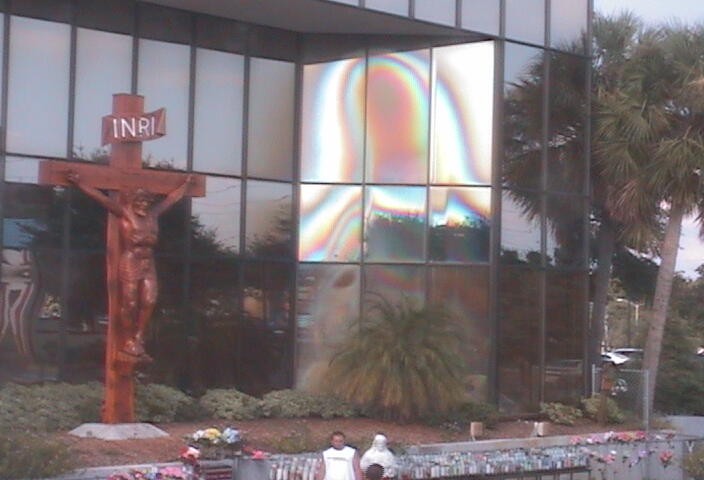
September 14, 2003 at 5:21 p.m.
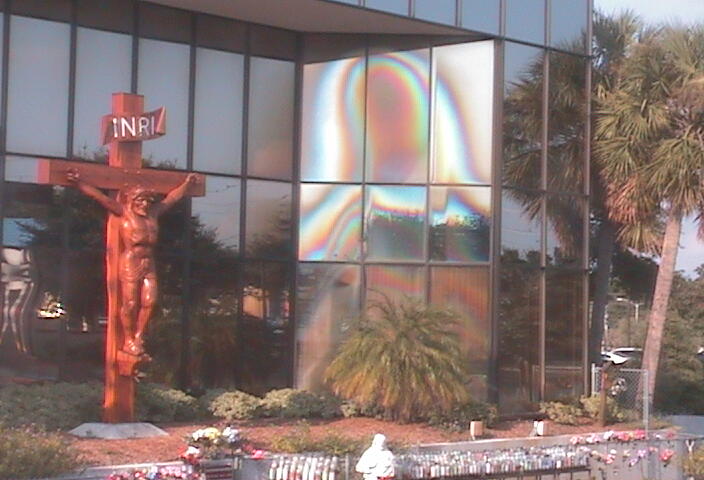
September 14, 2003 at 5:34 p.m.
September 14, 2003
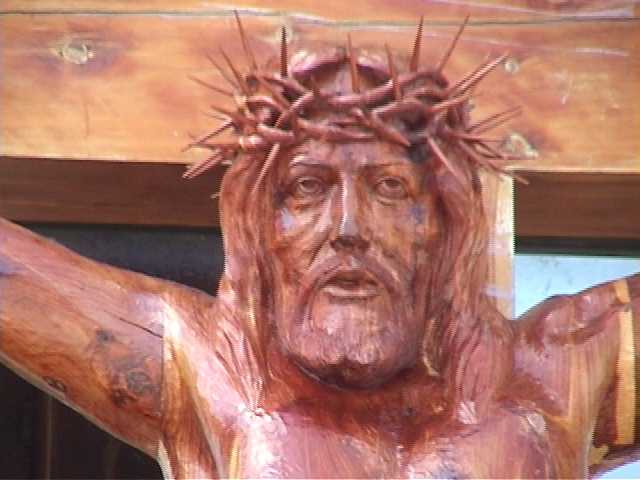
Triumph of the Cross
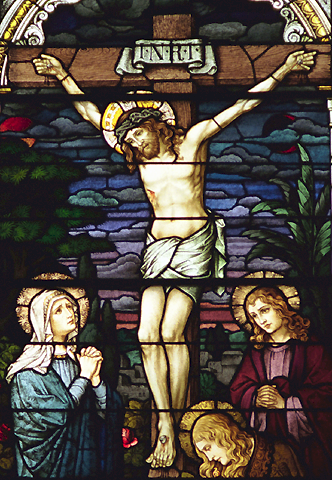
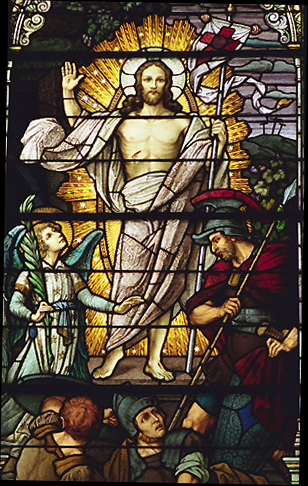
Numbers 21: 4-9
They left Mount Hor by the road to the Sea of Suph, to skirt round Edom. On the way the people lost patience. They spoke against God and against Moses, Why did you bring us out of Egypt to die in the desert? For there is neither food nor water here; we are sick of this meagre diet.
At this, God sent fiery serpents among the people; their bite brought death to many in Israel. The people came and said to Moses, We have sinned by speaking against Yahweh and against you. Intercede for us with Yahweh to save us from these serpents. Moses interceded for the people, and Yahweh replied, Make a fiery serpent and raise it as a standard. Anyone who is bitten and looks at it will survive. Moses then made a serpent out of bronze and raised it as a standard, and anyone who was bitten by a serpent and looked at the bronze serpent survived.
Philippians 2: 6-11
Who, being in the form of God,
did not count equality with God
something to be grasped.But he emptied himself,
taking the form of a slave,
becoming as human beings are;
and being in every way
like a human being,
he was humbler yet,
even to accepting death,
death on a cross.And for this God raised him high,
and gave him the name
which is above all other names;so that all beings
in the heavens, on earth
and in the underworld,
should bend the knee at the name of Jesus
and that every tongue should acknowledge
Jesus Christ as Lord,
to the glory of God the Father.
John 3: 13-17
No one has gone up to heaven
except the one
who came down from heaven,
the Son of man;
as Moses lifted up the snake in the desert,
so must the Son of man be lifted up
so that everyone who believes
may have eternal life in him.
For this is how God loved the world:
he gave his only Son,
so that everyone who believes in him
may not perish
but may have eternal life.
For God sent his Son into the world
not to judge the world,
but so that through him
the world might be saved.
Excerpt from Response in Christ,
by Father Edward J. Carter, S.J.
ONE The Concept of
the Christian Life
There are various points of departure for a treatment of the Christian life. Our particular choice consists in giving a general, panoramic view of this life in this chapter with a consequent deepening of ideas in the pages to follow. Inevitably the themes put forth here will receive only a sketchy treatment, and to this extent the chapter will not give complete satisfaction. However, such a procedure allows for an immediate view of our complete life of grace in Christ. This preliminary glimpse can consequently serve throughout as a constant, unifying frame of reference.
The Christian life essentially consists in God's loving self-communication to us with our concomitant response to Him in love. One peculiar characteristic of this communication of God to man is that it has centered itself within a concrete historical framework. God's gift of Himself therefore establishes the process of salvation history. This process began with man's creation and elevation to the supernatural life, a life which is a participation in God's own divine life. This participation is real and, therefore, somewhat similar to life as it is in God Himself; however, since it is only a created sharing, man possesses it in an infinitely less perfect manner than God who is Himself this life.
Man rejected this self-communication of God in original sin. Yet God's desire to give Himself to man was not withdrawn. He determined to save man from his sinfulness, and thereafter the divine communication centered around the promised Redeemer. Salvation history preceding the advent of this Redeemer became a preparation for the Redeemer's coming. From the time of His coming, salvation history was and is the establishment and continuation of His redemptive work.
1. The Christian Life as Prefigured in the Mosaic Covenant
In the age prior to the coming of Christ, salvation history was rooted in the Mosaic period. At the heart of this Mosaic era was the great salvific event of the exodus (Ex 15:1-18). Through this event Yahweh led the Israelites out of Egyptian slavery and under Moses formed them into His People. The history of the Jewish people previous to this exodus event was merely a preparation for this central happening. Thus Israel in recalling its ancient traditions could see that Yahweh's covenant with Abraham, Isaac and Jacob was a preparation for the great covenant definitively established through Moses on Mount Sinai.
God, then, within the framework of salvation history has determined to communicate Himself according to a covenant. What is covenant? In reference to salvation history it is a mutual life relationship in love between God and His People, and among the People themselves. God on His part communicates His own life through grace, and man in return gives himself to God and his fellowman in loving service. There are various laws governing the multiple aspects of this life-relationship. There is a formal worship with its determined ritual. Yet everything centers around the essence of covenant, the life relationship.
As mentioned, the Mosaic covenant dominated the Old Testament period. At the heart of the formation of this covenant there was a transition process involved as the Jews were led forth from Egyptian slavery to freedom under the leadership of Moses. The Egyptians had finally consented to this departure of the Jews under the pressure of the last of the plagues inflicted upon them. Under this plague the Egyptians' first-born were slain. The Jews escaped this deathblow of Yahweh by marking their doorposts with the blood of the paschal lamb: ". . . I will go through the land of Egypt and strike down all the first-born in the land of Egypt, man and beast alike, and I shall deal out punishment to all the gods of Egypt, I am Yahweh! The blood shall serve to mark the houses that you live in. When I see the blood I will pass over you and you shall escape the destroying plague when I strike the land of Egypt." (Ex 12:12-13).
As the Jewish people escaped from Egyptian bondage they experienced a transition which was essentially religious in nature. This transition was from a less perfect to a more perfect type of existence, for in being released from slavery they were gradually formed into Yahweh's People. The definitive event of this formation occurred on Mount Sinai. Here the covenant between Yahweh and His People was sealed with sacrificial blood. Moses sprinkled with blood both the altar, representing Yahweh, and the Jewish people. Since blood signified life for the Jews, such an action had deep meaning for them. It symbolized the sealing of the covenant, the establishment of a new life-relationship between Yahweh and themselves.
2. Life in the New Covenant
This Mosaic covenant prefigured the covenant which was to be established in Christ. Yahweh had given himself to the Jews in a special way. He was their God and they were His People. This life relationship was highly imperfect, however, if compared to that instituted by Christ. The covenant life between God and man established by the Incarnate Word is of the most intimate nature. We see this if we consider the new covenant as being contained in a perfect way in Christ Himself. He is radically the new covenant.1 Covenant, remember, has various dimensions of love. Out of love God shares His life with man, and man in community responds in love by giving himself to God and relating in love with his neighbor. In Christ we perceive these relationships achieved in the most perfect manner possible. First of all, Christ in His humanity receives the divinity's gift of self in the highest degree to such a high degree, in fact, that we have the hypostatic union as a result. In other words, the human nature of Christ is recipient of God's self-communication in such a perfect manner that it does not exist by reason of its own personal act of existence, but rather by the divine existence of the Word, the second person of the Trinity.
Christ as man in the name of all men, for all men perfectly receives God's communication of Himself in grace. This is the first movement of covenant life, downward from God to man. In the second movement of covenant, man's response, we again see Christ as central. As man, Christ makes the perfect response to God for all men. This response of Christ includes both His love for His Father and His relationship in love with men. His entire life was itself this perfect response. His life, submerged in a constant, loving conformity to His Father's will, was and is the perfect incarnate response which man is called upon to make to his covenant God.
The response which Christ made was centered in His death and Resurrection. These two events contained the whole of Christ's life and are intimately united. Everything which Christ did previous to Calvary was a preparation for Calvary and consequently shared its redemptive value. The Resurrection was in one way or another the completion of the work of Calvary. Since Christ's perfect response to the Father culminated in His death-resurrection, it is evident that Christ's life involved a transition just as did the life of the Jewish people in the old covenant. This transition of the Israelites was manifested in the exodus from Egypt. In fact, Christ's transition in death-resurrection was a fulfillment of the Jewish exodus; and just as the transition of the Jews marked a passage from a lower to a higher type of existence, so did Christ's transition or passover have this characteristic.
What was Christ's transition? Before Christ experienced death, He was limited by the sinfulness of the world into which He had immersed Himself in His Incarnation. He loved men, and He loved to be in their midst, and in the midst of their world. But He did suffer from the sinfulness of this world. Sinless though He Himself was, He was in certain ways affected and limited by sin. Indeed, sin destroyed Christ in his mortal existence. This shows us the degree to which Christ was limited by or "hemmed in" by the world's sinfulness. But through the passageway of His death, Christ passed beyond the limitations He had experienced in His mortal life. He conquered sin, and He rose into a more perfect type of life, that of the Resurrection. In such a life He could no longer suffer, He could no longer be "limited" by the sinful aspect of the world.
There is another similarity between the Jewish transition or exodus and the transition involved in Christ's death-resurrection. We saw the part that sacrificial blood contributed to the passover or transition of the Jewish people in two instances. The blood of the paschal lamb freed the Jewish homes from the deathblow of Yahweh immediately before their departure from Egypt, and ultimately it was sacrificial blood which sealed the Mosaic covenant upon Mount Sinai.
Sacrificial blood was also essential in Christ's passover or transition. It was through the shedding of His blood that He passed through death to Resurrection. It was thus His blood which made the transition possible and which sealed the new covenant. This new covenant, supplanting the old, is the new life relationship between God and His People, and the People themselves. Christ, in achieving new life through death-resurrection, gained it not only for Himself but for all His members.
The Christian, then, shares in the life of Christ's Resurrection. But if he participates in the Resurrection of Christ he must also share in Christ's death, since death is the way to Resurrection. St. Paul tells us: "We are dead to sin, so how can we continue to live in it? You have been taught that when we were baptised in Christ Jesus we were baptised in his death; in other words, when we were baptised we went into the tomb with him and joined him in death, so that as Christ was raised from the dead by the Father's glory, we too might live a new life." (Rm 6:2-4).
Through Baptism therefore the Christian is incorporated into Christ's death-resurrection. Baptism pledges the Christian to die to sin and ideally to all that is not in accordance with God's will, even though sin is not involved. Baptism also pledges the Christian to live vitally his new life in Christ, his share in Christ's Resurrection. As he is incorporated into Christ through baptism, the Christian is also made a member of the Church. Awareness of this simultaneous incorporation into both Christ and the Church emphasizes for the Christian the fact that his life of holiness in Christ is to be lived out in community. In other words, the Christian lives in Christ within the People of God, within the Church. This stress of contemporary spirituality upon the communal aspect of Christian holiness is firmly rooted in God's revealed truth. Throughout salvation history God has lovingly communicated Himself to man within the covenant framework with its communal dimension. He has also asked for man's response in love within this same covenant framework.
The Church in union with Christ is the new covenant. Since Christ is the Head of His Church, it follows that the Church with her members must live out the covenant life according to the structure which Christ gives her. The Church has no life, no pattern of life, except that which Christ gives her. This basic pattern or structure is death-resurrection. Christ established the Church by His paschal mystery, His death-resurrection. In so establishing the Church by such an event, Christ also determined how the Church essentially lives out her covenant life down through the ages through death and Resurrection.
The Church, then, continues Christ's death-resurrection. She consequently continues the entire mystery of Christ, since Christ's entire life is contained in His passover event.2 We see therefore why the Church can be referred to as the continuation of the redemptive Incarnation. Indeed the Church is Christ, the mystical Christ. Because she is the earthly continuation of Christ, the Church has everything within her structure needed to be the source of salvation and sanctification for men of all times. For instance, in reference to the presently much-discussed theme of the Church's relevancy to modern man, we know from theological reflection that the Church has this relevancy radically structured within her very existence. This is simply an application of the reality that the Church actually does prolong the mission of the Incarnate Word; since Christ was relevant to His age, the Church has the capacity to be relevant to all ages.
What do we mean by saying Christ was relevant to His age? Christ revealed the Father and communicated the Father's life to men by adapting Himself in a fundamental way to the life situation which existed at that particular time in Jewish history. Since Christ through His humanity adapted His message to the people of His times, so the Church must use her innate capacity to be relevant for the men of this or that age. She must in a sense be constantly reincarnating Christ, for she is the only visible Christ which this world now has. This reincarnation largely means being relevant.
As the Church is the continuation of Christ, so is the life of the Christian. Just as the Church centers her life in Christ's death-resurrection, so does the life of the Christian. Both Church and Christian then are continually dying with Christ, dying to all which is not of Christ. At the same time Church and Christian are meant to rise more and more with Christ, assimilating ever more perfectly His life through grace. This life of grace is the Church's and the Christian's share in Christ's Resurrection. It is true that this life of grace will have its completion only in eternity. Nevertheless, it does have very real beginnings here in this life.
It is therefore apparent why the Church's life is directed to the liturgy, especially the eucharistic liturgy.3 For it is within the liturgy culminating in the Mass that the death-resurrection of Christ is constantly renewed in a special manner. In the Mass the People of God have the constant opportunity to assimilate the death-resurrection of Christ more and more into their lives. As they do so collectively and individually, the People of God are continuing Christ's life and mission upon earth.
The Christian life, then, is a response to God's gift of Himself. God in love gives us a life of grace, a share in His own divine life. We respond in love by giving ourselves to God and our fellowman, by dynamically living out this life of grace, this Christ-life, in the pattern of death-resurrection. This life of grace is meant to be exercised constantly, as the Christian loves God and man, in Christ, according to the will of the Father. Also, to reiterate, God intends that our life in Christ be lived out in the community of the Church. The Christian life can never solely be an individual's response to his God.
As the Christian lives out this life of grace in community, he is offering Christ a new humanity through which He can reincarnate Himself. It is not only through the Church as a whole that Christ reincarnates Himself, but also, ideally, through each Christian within the Church. Each Christian has a special responsibility and privilege. No one else can offer Christ the unique opportunity of reincarnating Himself as can this or that particular Christian. For each Christian is a unique, created imitation of God never again to be repeated. Each Christian has a unique humanity to offer Christ. To the extent that he fails to do so, to that degree Christ has lost this opportunity to reincarnate Himself through this humanity.
Consequently, the Christian life can be conceived as the Christian permitting Christ to live more and more through his total person. Christian holiness is continual growth in the assimilation of that great thought of St. Paul, ". . . I live now not with my own life but with the life of Christ who lives in me." (Ga 2:20).
There are many ways in which the Christian can permit Christ to live in and through him. Love of the Father and love of all men, of course, are the two great themes which will channel this reincarnation of Christ. These were the great driving forces in Christ's life, and consequently they will be so in the life of the Christian.
If the Christian is to grow in projecting Christ through his Christian personality, he must be aware of the many various ways in which Christ loved His Father, and His will. He must be aware of the various ways in which the Father's will comes to him, and thus he will realize the multiple ways in which he is to love the Father in embracing that will. The Father's will can come to him in joy and happiness or in pain and sorrow; in work or in relaxation; in a life of great obscurity as well as in a life which commands public attention; in frustration or in success. These and many other channels of the Father's will offer the Christian the opportunity to continue this witness of Christ's life: no matter how easy or difficult, the Father's will must be lovingly embraced in all things. This is how Christ radically saved the world. This is how the Church, living according to the same principle, cooperates with Christ in furthering His redemptive work.
Christ's great love and concern for men must also be continually reincarnated through the Christian. Contemporary spirituality makes considerable use of personalism.4 One basic way we can apply personalism to our present theme is as follows: God revealed His love to men in a concrete way, through a Person possessing a tangible, visible human nature. Although this tangible, historical Christ is no longer with us upon earth, the basic plan of the Father continues. To a considerable degree He still continues to give Himself, His love, through tangible, visible human natures. It is through the Christian united with Christ that God continues in many ways to make His love tangible, visible and human to mankind.
Through these brief indications we can realize the various and many possibilities through which Christ lives again in the Christian. As the Christian in this manner projects Christ to his contemporary world he relives the total mystery of Christ. All the mysteries of Christ's life will be apparent somehow in such a Christian existence. But as the Christian puts on Christ more and more, death-resurrection will be especially apparent. For the Christian will be more and more going out of a self-centered existence, dying to that which is not really life at all, and increasingly passing over into a greater existence, into the life of Christ Himself. In this manner the Christian continues that transition process of passing from a lower to a higher mode of existence. We have seen this transition process to be at the heart of salvation history. We saw it in the exodus-event of the Jewish people. We saw it in the death-resurrection of Christ. We continue to find it in the life of the Christian as he prolongs the paschal mystery of Christ.
Yes, we live a new life in Christ. Christ, therefore, wants to share everything relating to our existence sin alone excepted. When He united us to Himself in assuming human nature, He united to Himself all our authentic concerns, values and interest. He is truly a man, and He wants to share with us all our truly human experiences. He and His grace want to touch these experiences. Nothing which is really human is alien to our life in Christ.
We enjoy the freshness of a bright clear day, the stillness of the night, the innocence of a little child, the companionship of a friend, the relaxation or stimulation of a good movie. Christ wants to share these joys with us. In our daily work there is a sense of satisfaction, accomplishment and joy there also can be pain, disappointment and misunderstanding. Christ wants to be there in the midst of all.
A strong, young American, the pride of his father, and full of promise, goes off to war. One day he fights his last and is no more. His father is in anguish and sorrow, and we sympathize. We observe the hatred and suspicion which exists between many white men and many black men, and our hearts grieve. Science achieves a great new discovery, and we are glad for this progress of the human race. A young man and woman are deeply in love, they marry, and their joy is great. And we rejoice with them. All these human experiences Christ wants to share with us, for He, too, is a man. The Christian actually is in Christ, and we must be bold enough to apply this reality to all the authentic areas of our existence. Christ wants it no other way.
The chief source of strength for the Christian as he lives in Christ is the liturgy, for this is the heart of the Church's life. Yet participation in the liturgy alone will not make certain the Christian's progress in holiness.5 The Christian must be constantly living out his previous participation. His life in Christ necessitates various types of activity which complement his liturgical life.
One such form of Christian endeavor is Christian asceticism. There are various reasons for asceticism in any age. Because of original and personal sin, the Christian has within himself many tendencies which are not in accord with Christ. Whether these involve the exterior senses or the interior senses and spiritual faculties, these tendencies must be controlled; otherwise, the Christ-life, the life of grace, cannot dominate the total person of the Christian as it is meant to do. Christian asceticism therefore embraces the traditional concept of mortification, namely a constant, reasonable control of the total person. Asceticism also includes the idea of organized effort in the spiritual life; it includes moreover the idea of renunciation and penance. These are traditional meanings of the term.
Yet Christian asceticism as contemporary thought conceives it goes further than mere control, organized effort, renunciation and penance. It embraces the reality of selflessness, a gradual going out from self-centeredness. As the Christian grows, his existential frame of reference becomes more and more Christ and others. To live means increasingly to love Christ and men. Paradoxically, the more the Christian goes out of himself, the more he authentically becomes himself, the more he becomes a true person. Viewed in terms of death-resurrection, Christian asceticism is seen to be more concerned with the death aspect of the paschal mystery. However, Resurrection is also present in a proper asceticism, for, among other reasons, Christian asceticism carries with it its own joy a share in Resurrection joy.
Asceticism and other expressions of the Christian life involve the exercise of the infused virtues, both theological and moral. These virtues can be conceived of in terms of supernatural faculties which give expression to our life of grace in Christ. These virtues, the chief of which are faith, hope and love, give the Christian all the capacities he needs to form meaningful, graced relationships with God, man and the rest of creation. (The horizontal dimension outward to man and creation is receiving special attention in the contemporary treatment of faith, hope and love.) Although the death aspect of the paschal mystery is present in the exercise of the virtues, we more easily identify these virtues with the Resurrection aspect of the paschal mystery. For the life of grace, with the infused virtues playing a dominant role, is our share in Christ's Resurrection.
The life of the Christian must also involve prayer. Why? Our life of grace is a created participation in Trinitarian life. What is life in God? It is essentially a life of knowledge and love. The life of the Trinity consists in the knowledge and love which exists between Father, Son and Holy Spirit. Then it is from the Trinity that the knowledge and love of God also goes out to creation.
Our life of grace is structured in the same manner. In union with Christ it essentially consists in knowing and loving God and in knowing and loving His creation, both on a supernatural level. Because this life of grace is centered in God, prayer is an absolute necessity. For prayer essentially is an interpersonal dialogue between God and the Christian. Without prayer the knowing and loving of God will never be what it should and neither will be the knowledge and love of God's creation. For one cannot envision, one cannot love man and the rest of creation without the intimate contact with God which prayer gives. This is because it is God's vision and God's love of His creation which the Christian shares in the life of grace.
The Christian, however, must not only pray. He must also externalize his life of knowledge and love in various ways. Today's spirituality with its incarnational trend stresses this fact.7 The Christian's life of Resurrection in Christ must to a considerable extent express itself in the daily world which surrounds him. This Christ-life must be expressed in the Christian's concern for the problems of the inner city and in his concern for a more just distribution of the world's wealth. It must manifest itself in the Christian's solicitude for the diseased and the poverty-stricken the world over. This life we have in Christ must incarnate itself in a concern over the spread of pornographic literature and other forms of godlessness. It must manifest itself as solicitous regarding the hatred which often exists between black man and white man. Our Christ-life must also express itself by our showing a tangible, warm love and interest toward those with whom we come into direct encounter.
This list of love and concern on the part of the Christian could be extended on and on. To what extent the Christian will manifest his concern in any of these areas will depend upon his vocation, the graces he receives and other circumstances. Our main point is this: the Christian through his life of grace in Christ has been called to further the creative and redemptive effort of God. He must, therefore, intimately involve himself in the affairs of this world. (Even the cloistered contemplative is called to involvement through such means as prayer.)
We have briefly indicated that the life of the Christian involves liturgy, asceticism, the exercise of the infused virtues, prayer and action. Rounding out such a list are other traditional aids to holiness, for example, spiritual reading, examination of conscience, spiritual direction. All of these are means of expressing our life of grace in Christ. They are also ways of growing in that life. All these should be seen in their connection with the Christian's participation in the passover mystery of Christ, His death-resurrection.
This first chapter has purposely centered the reality of the Christian life around the death-resurrection of Christ. In the remaining chapters we will expand upon the essentials we have treated briefly in these first pages. As we progress, we hope to show in detail that Christian holiness is life in Christ, for our life in Christ contains everything our love of God, our love of men, our love of all creation. We hope to portray the Christian as one who believes from the depths of his being that to live is Christ.
_______
1. Cf. Bernard Cooke, "Synoptic Presentation of the Eucharist as Covenant Sacrifice" in Theological Studies, Vol. 21, (1960), p. 36.
2. The Mystery of Christ is essentially one reality. Any of the individual mysteries implicitly contains the others. For a treatment of this, cf. L. Bouyer, Liturgical Piety (Notre Dame, Indiana: Notre Dame University Press, 1955), pp. 189-190.
3. Cf. Second Vatican Council, The Constitution on the Sacred Liturgy, No. 10.
4. Cf., for example, E. McMahon and P. Campbell, Becoming a Person in the Whole Christ (New York: Sheed & Ward, 1967).
5. Cf. Second Vatican Council, The Constitution on the Sacred Liturgy, No. 12.
6. Cf. Karl Rahner, Spiritual Exercises (New York: Herder & Herder, 1965) pp. 66-79.
7. Cf., for example, Second Vatican Council, Constitution on the Church in the Modern World, No. 34.end of Excerpt from Response in Christ
Sing: Take Lord Receive
We're desperately in need of
funds.
Envelopes are ready
to be mailed for priests
but we don't have
any postage money.
We need money for the
English speaking priestly mailing.
You can put it on your credit card,
call Morrow.
Shepherds of Christ Ministries
P.O. Box 193
Morrow, OH 45152
(toll free) 1-888-211-3041
1-513-932-4451
![]() Copyright
© 2003 Shepherds of
Christ.
Copyright
© 2003 Shepherds of
Christ.
Rights for non-commercial
reproduction granted:
May be copied in its entirety, but neither re-typed nor edited.
Translations are welcome but they must be reviewed for moral and
theological accuracy by a source approved by Shepherds of Christ Ministries
before any distribution takes place. Please contact us for more information.
All scripture quotes are from the
New Jerusalem Bible, July 1990, published by Doubleday.
Revised: September
14,
2003
URL: www.sofc.org
Contact Information for Shepherds
of Christ
Email: info@SofC.org
Shepherds of Christ Ministries
P.O. Box 193
Morrow, Ohio 45152-0193
Telephone: (toll free) 1-888-211-3041 or (513) 932-4451
FAX: (513) 932-6791